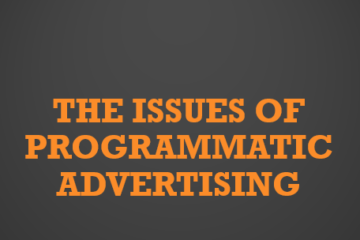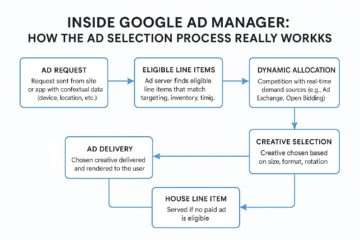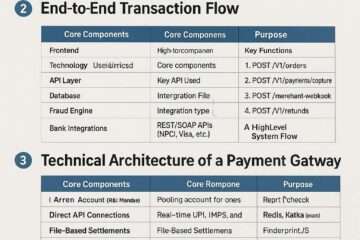

As a Programmatic Advertising Job Aspirant its equally important to understand the Demand Side Platform of Google which is DV 360. Lets discuss the Top 20 questions of DV 360 Series with answers and Explanations
1. What is DV360 and how does it work within the Google Marketing Platform?
Answer:
DV360 (Display & Video 360) is Google’s demand-side platform (DSP) that allows advertisers to purchase and manage display, video, TV, and audio ads programmatically across various ad exchanges and publishers. It is part of the Google Marketing Platform and offers tools for campaign creation, audience targeting, reporting, and optimization. DV360 provides a unified interface to manage digital campaigns and integrate with other Google tools like Google Analytics, Google Ads, and YouTube.
2. Explain the concept of programmatic advertising.
Answer:
Programmatic advertising refers to the use of automated technology and algorithms to buy and sell digital advertising space in real time. This includes the use of data to target specific audiences, the buying of ad space through real-time bidding (RTB), and the optimization of ad delivery. Programmatic advertising removes the manual steps involved in traditional ad buying and allows for more efficient, data-driven campaigns that can be adjusted in real time.
3. What are the main components of DV360?
Answer:
The main components of DV360 include:
- Campaign Setup: Allows for the creation and management of ad campaigns across display, video, and other media.
- Audience Targeting: Tools for defining and targeting specific audiences using first-party, second-party, and third-party data.
- Creative Management: Tools for uploading, trafficking, and optimizing creative assets such as banners and video ads.
- Bidding & Budgeting: Allows for setting up budgets, bidding strategies (CPM, CPC, CPA), and managing bid adjustments.
- Reporting & Analytics: Provides detailed reporting capabilities to track performance metrics such as impressions, clicks, conversions, and more.
- Inventory Management: A marketplace where advertisers can buy inventory from various publishers via open auctions or private marketplaces.
- Optimization Tools: Algorithms and machine learning models to automatically optimize campaigns for better performance.
4. What are the different types of programmatic ad buying?
Answer:
There are several types of programmatic ad buying:
- Real-Time Bidding (RTB): Ads are bought and sold in real time through an auction-based model. Advertisers bid for impressions as they become available.
- Programmatic Direct: Advertisers buy ad inventory directly from publishers at a fixed price without using an auction. This is a more predictable approach.
- Private Marketplaces (PMP): A blend of RTB and programmatic direct, where inventory is sold to a select group of buyers, typically at a fixed CPM.
- Guaranteed Programmatic: A fixed-price model where the advertiser secures inventory for a predetermined amount of impressions or views.
5. Can you explain the difference between a DSP and an SSP?
Answer:
- DSP (Demand-Side Platform): A platform used by advertisers to buy ad inventory from multiple sources. It enables programmatic buying, audience targeting, and campaign optimization.
- SSP (Supply-Side Platform): A platform used by publishers to manage and sell their ad inventory. It connects their available inventory to multiple demand sources (including DSPs) for automated selling.
6. What is real-time bidding (RTB)?
Answer:
RTB is a type of programmatic ad buying where ad inventory is bought and sold in real time via an auction. When a user visits a website or app, the impression is auctioned off to the highest bidder (advertiser) in a fraction of a second, enabling highly targeted and efficient ad delivery.
7. How do auction dynamics work in programmatic advertising?
Answer:
In programmatic advertising, auction dynamics refer to the real-time process of buying and selling ad impressions through auctions. When a user visits a website, an impression becomes available and is auctioned off to advertisers in the DSPs. Advertisers place bids based on their targeting criteria, and the highest bidder wins the impression. Bidding is often based on cost-per-mille (CPM), cost-per-click (CPC), or cost-per-acquisition (CPA), depending on the campaign goal.
8. What are the benefits of programmatic advertising over traditional methods?
Answer:
The main benefits of programmatic advertising over traditional ad buying are:
- Efficiency: Programmatic advertising automates the ad buying process, reducing the need for manual negotiation and placement.
- Data-Driven: Campaigns are optimized in real time using data for better targeting, which leads to higher relevance and improved ROI.
- Scalability: It allows advertisers to reach large audiences across multiple platforms and devices with minimal effort.
- Targeting: More precise targeting options are available, including behavioral, demographic, and contextual targeting.
- Real-Time Optimization: Advertisers can adjust bids and strategies based on performance metrics in real time.
9. What are the key metrics to measure the effectiveness of a programmatic campaign?
Answer:
Key metrics include:
- Impressions: The number of times an ad is shown.
- Clicks: The number of clicks the ad receives.
- Click-Through Rate (CTR): The ratio of clicks to impressions.
- Conversions: The number of desired actions taken by users (e.g., purchases, sign-ups).
- Cost-Per-Click (CPC): The cost of each click on the ad.
- Cost-Per-Action (CPA): The cost of each conversion.
- Return on Ad Spend (ROAS): The revenue generated from the campaign relative to the amount spent.
- Viewability: The percentage of ads that are actually seen by users.
- Frequency: The number of times an ad is shown to the same user.
- Engagement Rate: The level of interaction with the ad, such as likes, shares, or comments (for social ads).
10. What is an open auction in DV360?
Answer:
An open auction in DV360 is a type of real-time auction where inventory is available to all eligible advertisers. The highest bidder wins the ad impression. This is typically an open marketplace with no restrictions on who can participate.
11.Explain what private marketplace (PMP) deals are in DV360.
Answer:
A Private Marketplace (PMP) deal in DV360 is an exclusive auction where inventory is sold to a select group of advertisers. These deals are typically more controlled and negotiated by the buyer and the publisher. Advertisers may receive preferred access to premium inventory or audience segments at a fixed or negotiated price.
12. What is a direct deal in DV360?
Answer:
A direct deal in DV360 refers to an agreement between an advertiser and a publisher to buy ad inventory at a fixed price without going through an auction. The terms and pricing are pre-negotiated, offering more predictability and guaranteed inventory.
13. How does DV360 integrate with other platforms such as Google Ads, Google Analytics, etc.?
Answer:
DV360 integrates with multiple Google tools:
- Google Ads: DV360 can import campaigns, audience segments, and creative assets from Google Ads, allowing for cross-platform management.
- Google Analytics: Integration allows for importing audience data and tracking campaign performance across different platforms, providing better insights into user behavior and conversion tracking.
- Google Tag Manager: DV360 can work with Google Tag Manager to deploy tracking tags efficiently across websites and apps.
- Google Data Studio: Reports generated in DV360 can be integrated with Google Data Studio for custom visualization and reporting.
14. What is a media plan in DV360?
Answer:
A media plan in DV360 is a strategic document that outlines the details of an advertising campaign, including the target audience, goals, ad formats, budget, bidding strategies, and timelines. The media plan guides the execution of the campaign and is typically used by advertisers and agencies to structure their buying strategies.
15. What is an insertion order (IO) in programmatic advertising?
Answer:
An Insertion Order (IO) is a contract between an advertiser and a media vendor (or publisher) that specifies the details of an advertising campaign. It includes information such as the campaign start and end dates, budget, targeting details, creative assets, and payment terms. In DV360, an IO formalizes the agreement for buying inventory, particularly for direct deals.
16. What are audience segments in DV360?
Answer:
Audience segments in DV360 are predefined or custom groups of users that advertisers can target based on specific characteristics such as demographics, behavior, interests, and past interactions with websites or apps. DV360 allows advertisers to create their own segments or use segments from Google Audiences or third-party data providers.
17. How do you create and manage audience lists in DV360?
Answer:
Audience lists in DV360 can be created by:
- Importing from Google Analytics: Use data from Google Analytics to build audience segments based on user activity.
- First-Party Data: Upload data from your CRM or website to target your own users.
- Third-Party Data: Utilize third-party data providers to create more granular audience segments.
- Lookalike Audiences: Create audiences similar to your existing customer base. Once created, audience lists can be managed and optimized by adjusting targeting settings and refining segments based on performance.
18. What are first-party, second-party, and third-party data in programmatic advertising?
Answer:
- First-Party Data: Data collected directly from users interacting with a brand, website, or app. This includes customer data, website activity, and app usage.
- Second-Party Data: Data shared by a trusted partner or publisher, typically from a specific website or platform that collects data about its users.
- Third-Party Data: Data collected by external data providers that can be used to target broader audience segments. This includes demographic, behavioral, and interest-based data.
19. How do you use Google audiences for targeting in DV360?
Answer:
Google audiences in DV360 provide predefined audience segments based on users’ behavior across Google platforms (search, YouTube, Gmail, etc.). Advertisers can use these segments to target users based on their interests, browsing history, search behavior, and demographics. Common Google audience types include:
- Affinity Audiences: Groups based on interests.
- In-market Audiences: Users actively searching for specific products or services.
- Remarketing Audiences: Users who have interacted with a brand in the past. These audiences can be integrated directly into DV360 for targeting and campaign optimization.
20. What is geo-targeting in programmatic advertising?
Answer:
Geo-targeting refers to targeting users based on their geographical location, such as country, region, city, or even specific coordinates (latitude and longitude). In DV360, geo-targeting allows advertisers to focus their campaigns on users in particular locations that align with campaign goals, making ads more relevant to the user and potentially increasing conversions.




























































